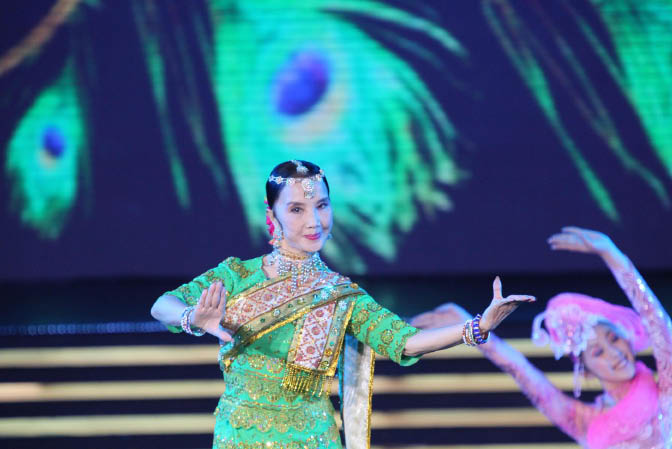|
The dance movements are usually performed in a fixed order. It starts with a peacock flying out from its nest, looking around cautiously. It roams the wild looking for food. Having had its fill, the peacock goes to the river bank to bathe and play in the water. After that, it shakes the water off, combs its feathers, and runs about enjoying the sunshine. When competing with other peacocks, it displays its beautiful tail to its rivals and to its beloved. At the end of the dance, the peacock spreads out its wings and flies joyfully into the sky.
To show a lively peacock, dancers must be very flexible as well as use a range of hand gestures and eye expressions. The knees must be especially flexible, which is a feature of Dai dance. However, dancers do not move the knees mechanically. Instead, the movements follow the performers' hearts and are in accordance with their sentiments.
Peacock dance has a repertoire of postures and steps involving arms, wrists, fingers and legs – soft movements that merge into an elegant dance style.
The hand gesture is one of the most important parts of imitating the bird. The dancer usually tucks in thumb, bends index finger, and spreads the rest into a fan shape to make the peacock's head. Their legs move swiftly. Sometimes the dancers tiptoe and sometimes they undulate, showing the agility and docility of the bird.
Percussion instruments such as the elephant-foot drum and gong accompany the dance. As with the peacock, the elephant is regarded as an auspicious animal by Dai people; the beast is sacred, diligent and brave. So, they make drums of various sizes out of mango or ceiba trunks and cover them with cowhide. The drums look exactly the same as an elephant leg.
Each gender has its own tempo. For instance, the drumbeat for a peahen is usually slow and light whereas it is rather quick for a peachick. Hence, the drumbeat is not just accompaniment, but helps tell the story, indicate the sentiments and, at the same time, express the performers' feelings.
The Peacock dance is performed by one dancer or a group of two or three. Traditionally, only men were allowed to perform. Dancers wore costumes that included golden headwear, a big mask and heavy wings. But these costumes restrained the performers' movements. In modern times females are allowed to dance, so heavy stage costumes have been replaced by gorgeous dresses decorated with peacock feathers. Female dancers showing peacock beauty to greater advantage are well received by the public.
In Yunnan, a Peacock dance is performed on almost all festive occasions, especially during Water-splashing Festival and Buddhist rituals. Water-splashing Festival is the New Year of the Dai ethnic group and is held on the 24th to 26th of the six month in Dai calendar (April in the Gregorian calendar). It is the most important Dai festival. People express their best wishes to each other by splashing water, which gets rid of evil spirits and bad luck. They hold a dragon boat race and set fireworks off to petition for a good harvest in the coming year. During the Water-splashing Festival, young people perform the Peacock dance joyfully. Young men and women throw embroidered purses they have hand-crafted themselves to their chosen beloved.
In 2006, the Peacock dance was listed as a national intangible cultural heritage. Renowned dancers such as Dao Meilan, Yang Liping and Yue Xiang have brought the dance to the global stage. Born and raised in Yunnan, these outstanding dancers are inspired by their beautiful landscape and abiding affection for nature and life.
|

|
|
Dao Meilan introduced elements of other ethnic dances into the native Dai choreography. Cnsphoto | | 